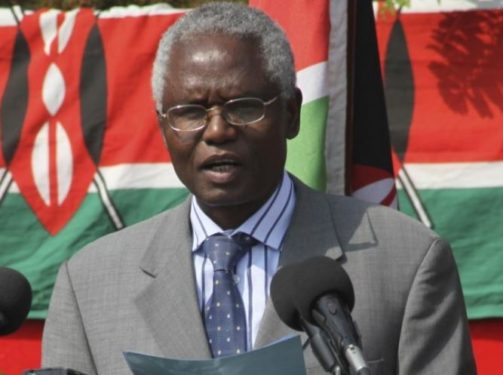
By Francis Muthaura
About a decade ago, Kenya embarked on a journey of a kind – to paint a long term picture of the future. This journey that produced Vision 2030, was a break from tradition as national development was previously guided by five-year development plans.
The crafting of Vision 2030 was inspired by successful implementation of ‘Economic Recovery Plan for employment and Wealth Creation’, an economic blueprint by the National Rainbow Coalition (NARC) government.
Originated in 2003 by the newly elected government, it was fine-tuned and cross fertilized with inputs from the then civil service that converted it into an implementable policy document. Implementation kicked off after Cabinet approval and endorsement by Parliament, delivering results beyond expectation, with targets surpassed.
There had never been a government plan that successful – pushing economic growth rate from a sluggish one per cent at the end of 2002 to an impressive seven per cent in 2007. The successful execution built confidence within government. Ministers and the civil service as well as investors were inspired to dream even bigger. This led to the eventual establishment of the National Economic and Social Council (NESC).
Initially proposed by Prof Anyang’ Nyong’o, then Minister for Planning & Economic Development, it was chaired by then President Mwai Kibaki, with Finance Minister, David Mwiraria as alternate chair.
The idea of crafting a long term development vision was broached at a meeting to report to the President on outcomes of the initial meeting of NESC. An enthusiastic President Kibaki asked the council to get back in a fortnight, leading to the roping in of management consulting firm, McKinsey to provide technical support.
A high-level workshop comprising Ministers and Permanent Secretaries and representation of CEOs of top companies and private sector organisations was convened in Naivasha to discuss a concept paper on a long-term vision for the country.
The discussion focused on four broad pillars for socio-economic transformation namely; Political, Economic, Social and the Enablers. At the workshop, there was consensus on the urgency and focus for the Vision 2030.
The ultimate vision that was crafted benchmarked with South Africa, Malaysia, Singapore and South Korea – not just on the countries’ economic growth, but also the quality of life for citizens. It was fashioned around the pillars – the political pillar to promote issue-based, people-centred politics for national cohesion and equitable sharing of resources; economic pillar; and social pillar to ensure a high quality of life. This document was eventually finalized and officially unveiled on June 10, 2008.
Looking back, it fills me with pride. The dream that became Vision 2030 has completely transformed the country. No one takes the country lightly anymore; we are a regional economic powerhouse. In just about a decade, the national GDP has increased more than five-fold, from just $12 billion at the time the NARC government took over to over $72 billion today.
Throughout the journey of crafting this vision, and ten years into implementation, a few lessons stand out. The vision identified a few high impact sectors, flagship projects and programmes to spearhead growth and transformation.
The targets were set high and the operational modality was business unusual. The sectors and projects selected included: agriculture, tourism, manufacturing, retail & wholesale, financial services, ICT, roads, energy and education.
Others are health and housing, Lapsset, Konza City, Jomo Kenyatta International Airport as regional hub, SGR and Mombasa Port, Special Economic Zones. These lessons are applicable for the country in future, counties and other organizations, or even other countries.
First, the process of developing the vision has to be inclusive to succeed. In order to craft and deliver a vision, it is important to involve and convince as many people as possible in order to create and sustain the momentum. It is in realisation of this that the process of developing Vision 2030 was deliberately inclusive, with a variety of stakeholders involved across political divide.
Constant Follow Up
Secondly, framing the target also made a difference. In coming up with the goal, it is not enough to just aim to be at par or ahead of another country. Neither is it challenging enough to aim at a given national income, since there is the risk of imbalances, yet the goal was to uplift living standards of Kenyans.
That is how we arrived at the target of achieving middle-income status by the year 2030. The future Kenya we envisioned had to have high standards of living and high incomes for all. It also had to be people-focused.
Finally, sustained focus on the identified priorities, constant follow up and prudence in execution made all the difference.
While we are happy that the country has achieved middle income status on global scale, we nevertheless are faced with wide spread youth unemployment and a large segment of our population is still entrapped in the vicious cycle of poverty.
The Big Four priority agenda by the Jubilee Government intended to fast track the Vision 2030 targets could not have come at a better time. In particular, the industrialisation strategy has been lagging behind and should be the answer for massive employment creation.
Whereas more work still remains to be done to deliver the Kenyans the promised land, as envisioned in the vision, huge strides have been made. The challenge is now to consolidate the gains and learn from the lessons.
—The writer is retired Head of Civil Service and was involved in crafting Vision 2030.
Read more at: https://www.standardmedia.co.ke/business/article/2001283521/three-key-lessons-on-growing-the-economy-from-kenya-s-vision-2030
